The Walking Liberty Half Dollar, widely regarded as one of America’s most beautiful coin designs, holds secrets beyond its stunning artistry. While most collectors focus on key dates and silver content, the real treasure lies in hunting for rare error coins that can transform a $20 piece into a five-figure windfall.
From 1916 to 1947, mint production challenges created extraordinary varieties that escaped quality control, resulting in some of the most dramatic and valuable errors in U.S. numismatics. These coins can be worth anywhere from $10 to more than $100,000, based on the date and condition, but error varieties add an entirely new dimension to collecting potential.
Whether you’re examining doubled dies worth $15,000, off-center strikes commanding $41,000, or the famous “Headless Walker” that sold for $16,200, understanding these 11 rare error types could be the difference between spending pocket change and discovering a genuine numismatic fortune. Let’s explore the most valuable Walking Liberty error coins that serious collectors actively seek.
Doubled Die Errors
1. DDO (Doubled Die Obverse)

The Doubled Die Obverse (DDO) occurs when a coin’s die receives multiple misaligned impressions during the die-making process, resulting in doubled images on the coin’s obverse. As a true die variety, the doubling appears on every coin struck from that die.
The most prominent doubling typically appears on “IN GOD WE TRUST,” the date, and Liberty’s lower gown folds. Unlike strike doubling, both sets of text on DDO coins are raised from the field, creating crisp, well-defined doubling. Clear separation between letter serifs proves the doubling was created during hubbing rather than during coin striking.
Notable Walking Liberty DDO varieties include the 1936 DDO FS-102 with doubled features including date, IN GOD WE TRUST, lower folds of skirt, shoes and the ground. Values are substantial: the 1936 DDO FS-101 achieved $15,000 in VG10 condition, the 1946 DDO FS-101 commanded $2,585 in MS66, while the 1936-D DDO FS-101 reached $5,760 in MS67. These varieties remain highly sought after by collectors due to their visual appeal and relative scarcity.
Known DDO Error Years for Walking Liberty Half Dollar (1916-1947):
2. DDR (Doubled Die Reverse)

While doubled die obverse errors affect the front of the coin, Doubled Die Reverse (DDR) errors create dramatic doubling on the back design elements. These errors occur when die misalignment during the hubbing process creates distinct doubling on the coin’s reverse design elements.
The 1946 DDR FS-801 is the series’ most famous variety. This is probably the most sought after doubled die variety in the Walking Liberty series, with doubling especially prominent on the eagle’s left wings and on E PLURIBUS UNUM, especially on the L and the first U in PLURIBUS and the second U in UNUM. The doubling is often visible without magnification, making it popular with collectors who can easily spot it.
This variety achieved a record price of $9,400 for a 1946 MS 66+ example at Heritage Auctions. GreatCollections has sold 98 examples over 14 years, with prices ranging from $27 to $6,669 in grades 1 to 66+.
The 1942 DDR FS-801 is less common but equally dramatic. The doubled die splits are most evident for HALF DOLLAR, UNITED STATES OF AMERICA, olive branch, and lowest areas of the eagle. This variety commands $12,500 in higher grades.
Known DDR Error Years for Walking Liberty Half Dollar (1916-1947):
Mint Mark Errors
3. RPM (Repunched Mint Mark)
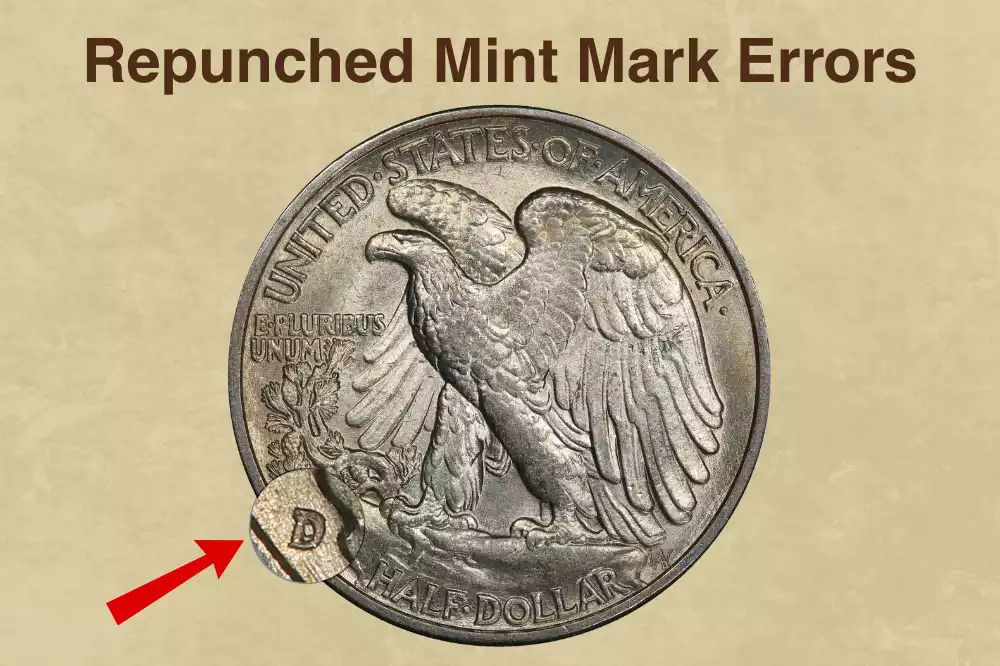
Re-punched mint mark errors (RPM) occurred when workers needed to punch the mint mark multiple times to achieve a satisfactory impression. If the initial punch wasn’t clear enough, they would strike again at slightly different angles or positions, creating a doubled effect on the mint mark.
When the punch shifted between strikes, it resulted in a double image of the mint mark, with the second image appearing out of line with the first, sometimes even rotated. This manual process during the Walking Liberty era made RPM varieties a natural byproduct of the mint mark application technique.
The Walking Liberty series features several notable RPM varieties. The 1916-D/D FS-501 shows The second D is partially evident under the bolder D and to the left of mint mark, making it especially valuable as 1916-D is already a key date. Other significant RPMs include 1939-D/D, 1941-D/D, 1941-S/S, and 1944-S/S, all designated as FS-501 varieties.
The most dramatic example is the 1946-S/S RPM, which “The most exciting part of this variety is the RPM. The second S is only lightly struck, but has over half a letter separation.” This wide separation makes it one of the most visually striking RPMs in the entire Walking Liberty series. GreatCollections has sold 3 of the 1944-S/S Walking Liberty Half Dollar Repunched Mintmark FS-502 over 15 years, with prices from $24 to $260, in grades 30 to 64.
While specific auction records are limited, RPM varieties consistently command substantial premiums over regular issues, particularly when combined with scarce dates or high grades.
Known RPM Error Years for Walking Liberty Half Dollar (1916-1947):
Striking Errors
4. Off-Center Strikes
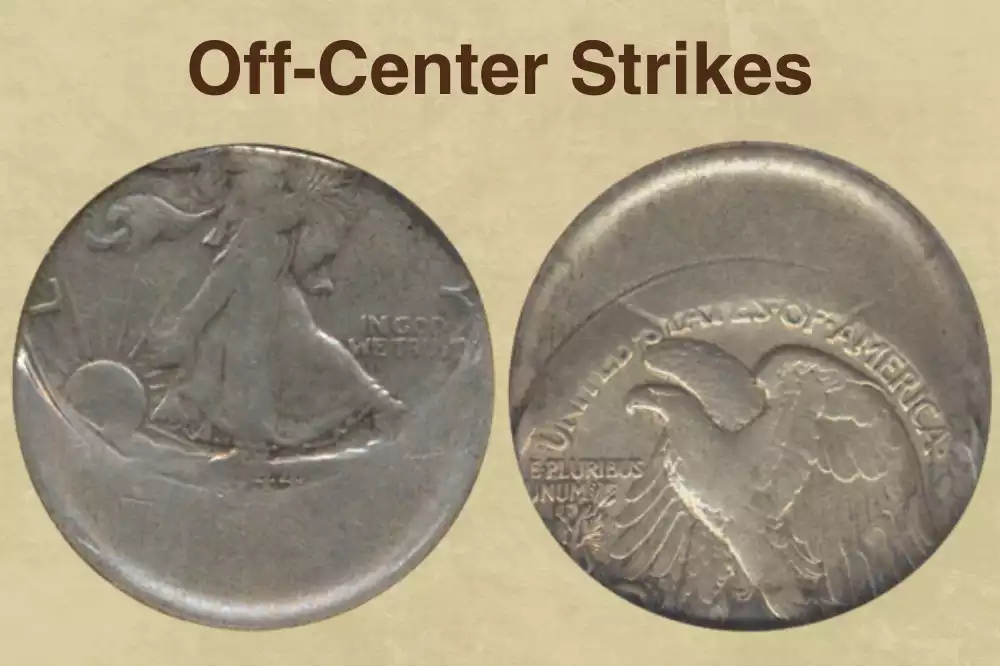
Off-center strikes occur when a planchet is not properly positioned between the dies during striking, resulting in the design being only partially struck on the planchet. The resulting coin shows partial design elements with a blank, unstruck area where the dies missed the planchet.
This error happens when the collar mechanism fails to properly center the planchet. The collar prevents the metal of the blank from flowing outside the confines of the die, but when it malfunctions or the planchet shifts position, an off-center strike occurs. Without proper positioning, only the portion of the planchet under the dies receives the strike.
The percentage off-center can range from minor 5-10% shifts to dramatic examples exceeding 70%. The percentage off-center indicates how much planchet and design is missing or visible on the coin, with 40% to 60% off-center generally considered the “perfect” percentage for collectors.
Values for these errors reach impressive levels. A spectacular 1945-S example had its second strike 55 percent off-center at 8 o’clock relative to the obverse and sold for $41,125, earning recognition as “the most dramatic multi-struck Liberty Walking half dollar known.” Another significant piece, struck 70% off-center where you can only see up to Lady Liberty’s waist, commanded $23,000. The combination of visual drama, extreme rarity, and collector demand drives these exceptional prices.
Known Off-Center Strike Error Years for Walking Liberty Half Dollar (1916-1947):
5. Double Strike Errors
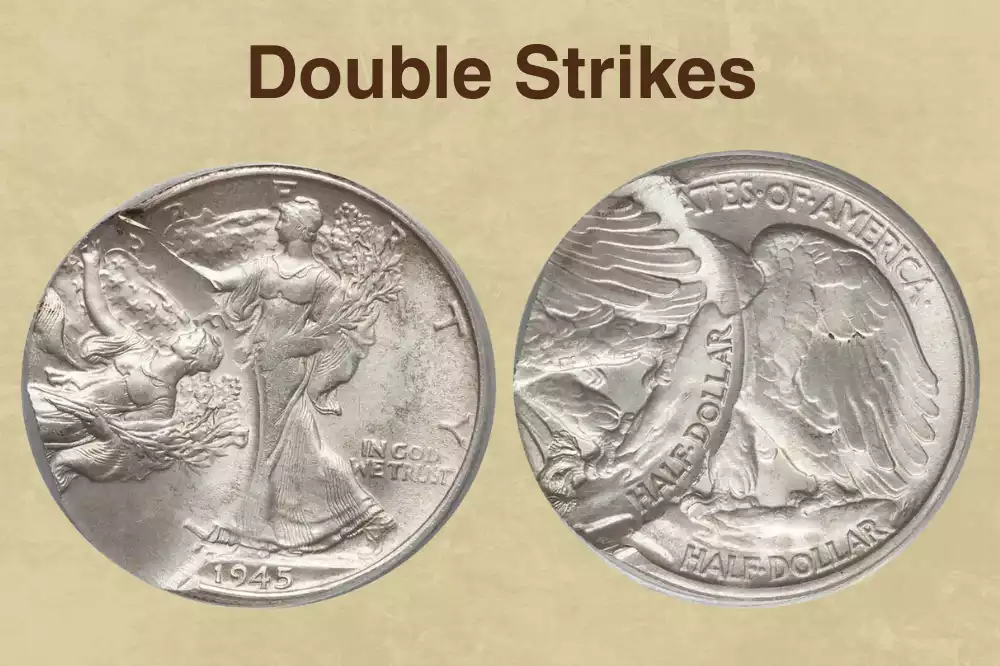
Double strike errors occur when a coin fails to be properly ejected from the coining press after its initial strike and is then struck a second time by the dies. This results in two or more overlapping images of the coin’s design on the same planchet.
The error happens due to ejection mechanism failure in the coin press. Normally, after the first strike, the coin should be automatically ejected from the striking chamber. When this fails, the coin remains positioned between the dies and receives a second impression, often at a different position or angle than the first strike.
The most valuable example is the 1945-S double strike, recognized as “the most dramatic multi-struck Liberty Walking Half Dollar known.” After a first normal strike, this coin failed to eject properly and was struck again 55% off-center. This spectacular piece achieved $41,125 at Heritage Auctions in MS63 condition.
San Francisco Mint examples dominate the high-value sales, with the other two sold by Heritage Auctions for $41,125 and $32,900. There are different types: On-Center Double Strike occurs directly on top of the first with slight rotation, while Off-Center Double shows the coin shifted position between strikes.
Values depend on three key factors: the percentage of offset between strikes, visibility of important design elements like the date, and overall condition. The combination of extreme rarity and dramatic visual impact makes double strikes among the most desirable Walking Liberty errors.
Known Double Strike Error Years for Walking Liberty Half Dollar (1916-1947):
6. Broadstrike Errors

A broadstrike error occurs when a coin is struck outside the collar, which is the retaining ring that establishes the final diameter of the newly-struck coin. Understanding this error requires knowing how coins are normally made: during striking, the collar surrounds the blank to contain the metal and form the coin’s proper shape and edge.
When the collar malfunctions or fails to engage, the metal has no boundaries to constrain it. Without a collar to keep things in order, the coin becomes wider and less contained than intended, deforming the rim of the piece. The result is a coin that is thinner and wider than normally struck coins, with an incomplete edge and missing or misshapen rim.
The critical diagnostic feature separates broadstrikes from off-center strikes: in order to qualify as a Broadstrike, the coin’s full design must be present on both faces. If the design is cut off on either face, the error is called an “Off-Center Strike”. All denominations of U.S. coins with a broadstrike have plain edges instead of the normal reeded edges found on Walking Liberty Half Dollars.
Walking Liberty broadstrikes are exceptionally rare. Documented examples include a 1945 50C Walking Liberty PCGS AU55 broadstrike, demonstrating that these errors occasionally escaped the mint’s quality control during the series’ production years. The combination of extreme rarity and the Walking Liberty’s popularity ensures strong collector demand, with values typically ranging from hundreds to thousands of dollars depending on the degree of expansion and overall condition.
Known Broadstrike Error Years for Walking Liberty Half Dollar (1916-1947):
7. Stuck Through Errors
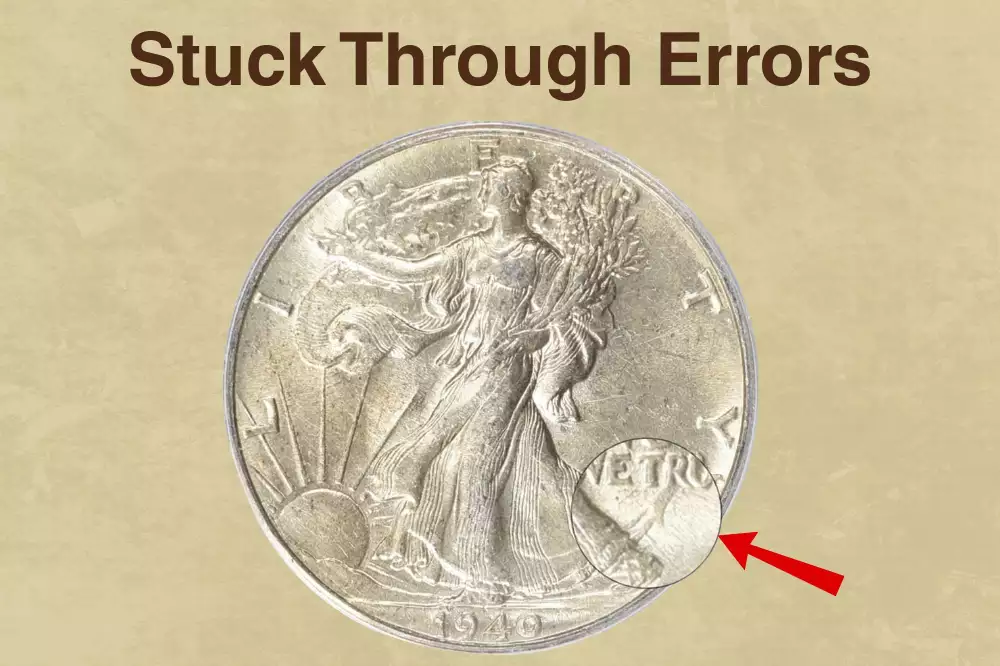
Struck through errors occur when foreign material comes between the die and planchet during striking, leaving an impression on the coin’s surface. When dies should be clean and free of debris, contamination interferes with normal production, resulting in missing or weakened design elements.
Common materials include grease (the most frequent), cloth fibers, wire, metal shavings, staples, and even pieces of other coins. Grease errors occur when oil needed to maintain press machinery gets onto the die surface, creating smooth, depressed areas where design details are obscured or completely missing.
Walking Liberty examples include a 1943 P half dollar struck through grease with missing letters “OLLAR” in “DOLLAR” and a 1934 struck through grease example graded NGC MS62. These grease-filled die errors often result in weak or missing design details in affected areas.
Values vary widely based on the size, location, and clarity of the struck-through material, typically ranging from $50 for minor instances to $500+ for dramatic examples. For significant value, grease strikes must affect substantial portions of the design rather than just missing individual letters or digits.
Known Struck Through Error Years for Walking Liberty Half Dollar (1916-1947):
Planchet Errors
8. Wrong Planchet Errors

Wrong planchet errors occur when a coin is struck on a blank intended for a different denomination. These errors happen when planchets from different denominations accidentally mix during production, storage, or transport at the mint.
The most documented wrong planchet errors in the Walking Liberty series involve half dollars struck on quarter planchets. Saul Teichman noted “only about 14 different examples” of Walking Liberty Half Dollars struck on quarter planchets were known. The size difference between the half dollar dies (30.61mm) and quarter planchet (24.26mm) creates dramatic visual effects, often cutting off significant portions of the design.
The most spectacular example is the 1942 “Headless Walker,” where Miss Liberty’s head is completely missing just above the shoulders. This coin was aligned with the Walking Liberty dies in such a way that the outstretched arm is also sans a hand, while the reverse shows an eagle whose feathers appear sheared across the bird’s left wing. This spectacular piece sold for a mind-blowing $16,200 during its 2018 Stack’s Bowers Galleries offering. Another 1942 example in AU-58 condition sold for $12,337.50.
Walking Liberty Half Dollars struck on dime planchets are even rarer. These rare coins generally show only a portion of the design (often appearing uniface) because the smaller planchet couldn’t accommodate the full image. The value of these scarce error coins typically ranges from $1,500 to $10,000 depending on the condition and how dramatically the error presents. For example, an AU55 specimen realized a whopping $4,560 on Heritage Auctions.
Known Wrong Planchet Error Years for Walking Liberty Half Dollar (1916-1947):
9. Clipped Planchet Errors
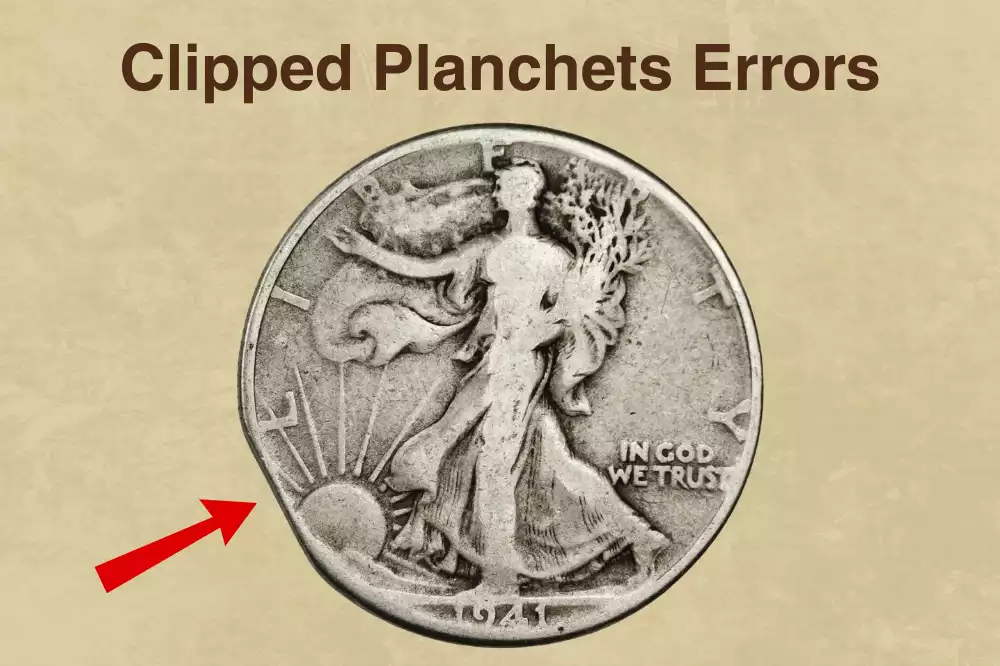
Clipped planchet errors occur when a coin blank is cut incorrectly during the minting process, resulting in missing metal along the edge that creates an irregular shape. These errors happen when the planchet strip is not fed properly into the blanking press or when there’s a defect in the strip itself.
The punches sometimes overlap the leading edge of the metal producing a straight clip, or strike an area that overlaps a previously punched hole, creating a curved clip. Curved clips are the most common type, while straight clips and ragged clips are less frequently encountered.
Authenticating genuine clipped planchets requires recognizing key diagnostic features. The Blakesley Effect appears as weakness in the design rim opposite the clip, where the edge becomes unusually wide. This occurs due to the absence of pressure in that area during the upset (or rimming) process. Metal flow patterns cause design elements near the clip to stretch or distort as the metal flows toward the missing area during striking.
Walking Liberty clipped planchets are documented but uncommon examples of this error type. The combination of the series’ careful production standards and the relative rarity of significant clips in high-grade examples makes them moderately collectible.
Most clipped planchets sell for just a few dollars, with rarer examples commanding $25 and up, depending on the size of the clip and overall condition. Larger clips typically command higher premiums, as a 75% clipped quarter might be worth $200 compared to just $5 for a 5% clip on the same coin.
Known Clipped Planchet Error Years for Walking Liberty Half Dollar (1916-1947):
Other Errors
10. Lamination Errors

Lamination errors are planchet defects that result from metal impurities or internal stresses, causing discoloration, uneven surfaces, peeling, and splitting. During planchet strip preparation, foreign materials such as grease, dirt, oil, slag or gas may become trapped just below the metal surface, creating poor adhesion that later causes coins to flake and peel.
A lamination error occurs when metal flakes off the surface of a coin or planchet. It is generally believed that the flaking, peeling, and cracking is due to impurities in the alloy which causes metal to separate along horizontal planes of weakness. These errors can develop either before or after striking.
Lamination errors are rather rare on 90% silver coinage compared to other denominations, making them somewhat scarcer in the Walking Liberty series. Values can range from a few dollars for slight laminations on common coins to $1,400 for dramatic examples on gold coins, with silver coins falling between these extremes. A documented example is a 1942 Walking Liberty Half Dollar with a lamination error, offered for $30.
Small lamination errors on common coins generally don’t command high premiums and may actually decrease value, while larger laminations are rarer and more valuable.
Known Lamination Error Years for Walking Liberty Half Dollar (1916-1947):
11. Weak Strike Errors
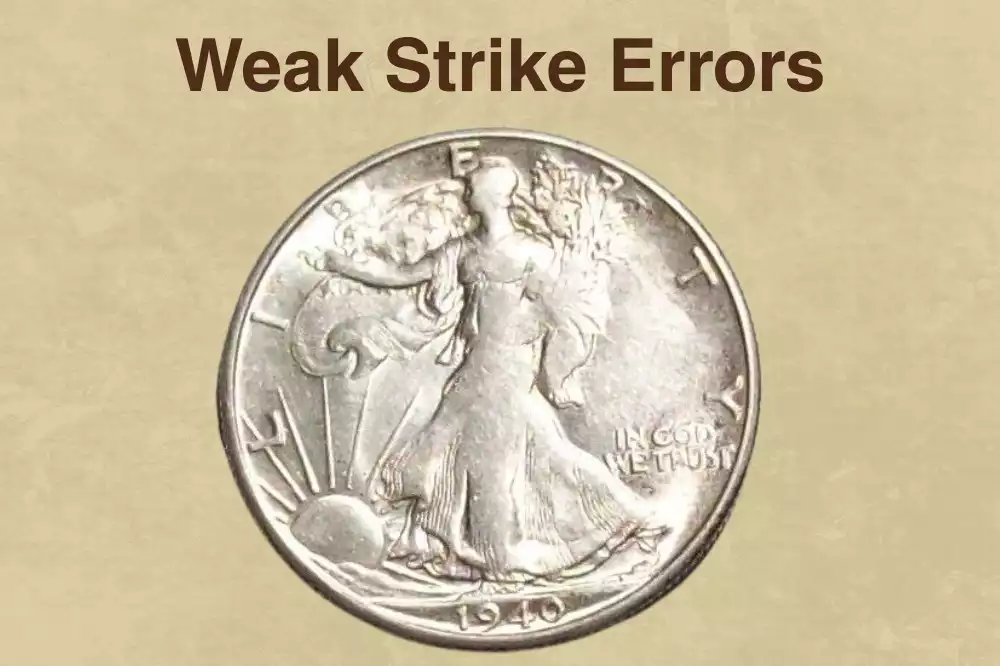
Weak strike errors represent one of the most common production issues in the Walking Liberty Half Dollar series. This error occurs when insufficient striking pressure or worn dies fail to fully bring up the coin’s intricate design details, resulting in mushy or incomplete features particularly on Liberty’s left hand and the eagle’s central feathers.
The San Francisco Mint particularly struggled with this issue. Research indicates over 60% of 1920s Walking Liberty Half Dollars show some degree of weak strike, with the 1940-S widely considered “the worst struck of all Walking Liberty Half Dollars”. The typical 1940-S is very weakly struck at Ms. Liberty’s left hand with many specimens showing no hand detail at all. The phrase “flat as a pancake” is very appropriate for this issue.
The problem extended throughout the San Francisco production. For the 1941-S, like all of the 1940-1946 San Francisco Mint Walkers, strike is a problem. Specimens are often encountered, even otherwise superb Gem examples, that are very weakly struck on Ms. Liberty’s left hand. The 1942-S Walking Liberty half dollar usually has a weak, mushy strike. The rare examples with a strong strike go for a premium.
While weak strikes generally diminish value, well-struck examples from typically weak-strike years command significant premiums. A sharply struck 1942-S with clear hand details and deep gown lines can sell for substantially more than typical mushy specimens. Full hand detail (called “Full Strike”) can double or triple the value of many coins — especially pre-1934 Walkers.
Known Weak Strike Error Years for Walking Liberty Half Dollar (1916-1947):
Conclusion
The Walking Liberty Half Dollar series offers far more than just beautiful design and silver content—it presents a treasure trove of error varieties that can dramatically increase a coin’s value. From doubled dies worth thousands to the legendary “Headless Walker” commanding five figures, these 11 error types represent some of the most sought-after varieties in American numismatics.
Whether you’re a seasoned collector or just starting your numismatic journey, learning to identify these errors could transform an ordinary coin purchase into an extraordinary discovery. The next time you examine a Walking Liberty Half Dollar, remember that beneath its artistic surface may lie a valuable error waiting to be found.
The post 11 Rare Walking Liberty Half Dollar Errors Worth Money (Full List with Pictures) appeared first on CoinValueChecker.














